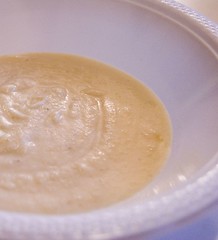
“What is that, Mommy?” my son asked suspiciously while pointing to a pile of knobby tubers that looks like little knots of ginger. “That’s a sunchoke, sweetie!” I said, and happily bagged up a pound.
Sunchokes are one of those vegetables that I reach for during this wacky window of time when the weather vacillates between Winter and Spring every few days. Prime time for sunchokes, which are best harvested after a frost and before their flowers bloom, is between the months of October and April, so let’s dig in and enjoy them while we can.
Sunchokes are also called Jerusalem Artichokes although they’re indigenous to right here in the U.S. of A. They’re also not artichokes, but the root systems of a member of the sunflower family with a cheery yellow bloom.
A centuries-old favorite among some Native tribes, food lore reports that sunchokes were discovered by Europeans after French explorer Samuel de Champlain sent some of these tubers to an Italian buddy who thought they tasted like artichokes and named "girasole articicco," meaning, "sunflower artichoke." The American corruption of the pronunciation lead to "Jerusalem" and the rest is history.
Eaten raw, sunchokes have a crisp, delicate flavor that is slightly sweet and nutty, similar to jicama and water chestnuts. However once cooked, the tubers take on a starchy texture, much like potatoes, and can be used in combination with or in lieu of potatoes in dishes like purees and gratins.
Speaking of starch, the botanically named Helianthus tuberosus stores its energy as inulin (a starch that is not used by the body unlike sugar and not to be confused with insulin) which is particularly good news for diabetics in because inulin breaks down into fructose instead of glucose during digestion, making sunchokes a good substitute for other starchy foods such as potatoes. Sunchoke flour is an alternative for those who are allergic to wheat and other grains.
Nutritionally, sunchokes are high in iron, thiamin and potassium and sunchokes also feed the healthy bacteria (lactobacilli) in the intestinal tract. Sunchokes cause flatulence in some people, which can be reduced by blanching or par-boiling the tubers before cooking.
To peel or not to peel? That is the question. If you choose fresh, firm, juicy sunchokes that aren’t overgrown then peeling them is really up to your discretion. Although the gnarly knobs look like ginger, the skin is much thinner and can be eaten. Larger sunchokes can be peeled with a paring knife or even a spoon. If you peel them, drop them in acidulated water (water with a squeeze of lemon juice or splash of vinegar) to prevent discoloration. It is also a good idea to dip peeled or cut sunchokes in acidulated water if you’ll be serving them raw, just like you would do with apples to prevent browning when exposed to air.
Peeled or not, since these are essentially roots, sunchokes should be scrubbed thoroughly before preparation. Avoid sunchokes with wrinkled skins, soft spots, blotched green areas or sprouts, but don’t be afraid of a light tinge of yellow, red or purple in the light brown skin depending on the soil in which they were grown.
Sunchokes are highly versatile and can be cooked like potatoes: baked, boiled, steamed, fried, and stewed. A bit of warning, though because they cook faster than potatoes and can easily be turned to mush in a matter of minutes. They are “done” when you can easily pierce them with a skewer or fork. To prevent discoloration in soups or gratins, try not to cook sunchokes in aluminum pans or pots made of reactive substances like iron.
_________________________________
Check out this
Sunchoke & Yukon Gold Potato Gratin or
Creamy Sunchoke & Celery Soup for recipe ideas!
Chef Asata Reid leads the Natural Foods Series offered monthly at Sevananda Natural Foods Market, where she has been a member since 2006. Through her Atlanta-based company, Life Chef, she leads cooking classes and healthy food seminars, and discusses all things food-related at www.lifechef.blogspot.com. As a mother and world-neighbor, she is also an advocate for healthy children and families through the Children's Wellness Network.


